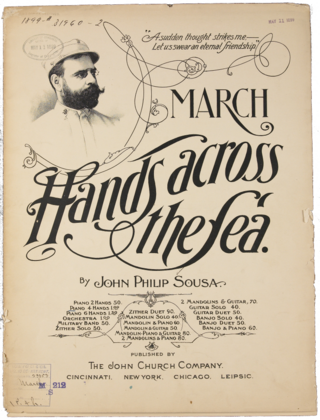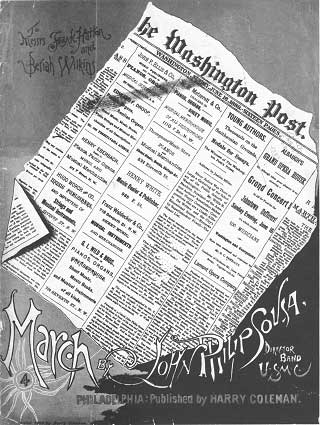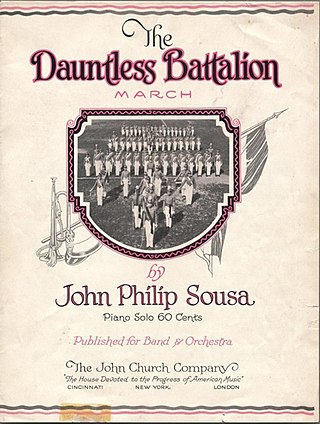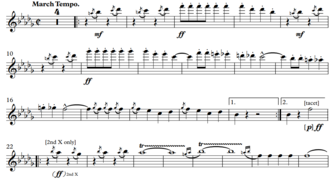
John Philip Sousa was an American composer and conductor of the late Romantic era known primarily for American military marches. He is known as "The March King" or the "American March King", to distinguish him from his British counterpart Kenneth J. Alford. Among Sousa's best-known marches are "The Stars and Stripes Forever", "Semper Fidelis", "The Liberty Bell", "The Thunderer", and "The Washington Post".

American march music is march music written and/or performed in the United States. Its origins are those of European composers borrowing from the military music of the Ottoman Empire in place there from the 16th century. The American genre developed after the British model during the colonial and Revolutionary periods, then later as military ceremonials and for civilian entertainment events.
"The Liberty Bell" (1893) is an American military march composed by John Philip Sousa.

"Hands Across the Sea" is an American military march composed by John Philip Sousa in 1899.

"The Stars and Stripes Forever" is a patriotic American march written and composed by John Philip Sousa in 1896. By a 1987 act of the U.S. Congress, it is the official National March of the United States of America.

"The Washington Post" is a march composed by John Philip Sousa in 1889. Since then, it has remained as one of his most popular marches throughout the United States and many other countries.
English Folk Song Suite is one of English composer Ralph Vaughan Williams' most famous works. It was first published for the military band as Folk Song Suite and its premiere was given at Kneller Hall on 4 July 1923, conducted by Lt Hector Adkins. The piece was then arranged for full orchestra in 1924 by Vaughan Williams' student Gordon Jacob and published as English Folk Song Suite. The piece was later arranged for British-style brass band in 1956 by Frank Wright and published as English Folk Songs Suite. All three versions were published by Boosey & Hawkes; note the use of three different titles for the three different versions. The suite uses the melodies of nine English folk songs, six of which were drawn from the collection made by Vaughan Williams’ friend and colleague Cecil Sharp.

"National Emblem", also known as the National Emblem March, is a U.S. march composed in 1902 and published in 1906 by Edwin Eugene Bagley. It is a standard of the U.S. march repertoire, appearing in eleven published editions. The U.S. military uses the trio section as ceremonial music for the entry of the ceremony's official party.
The Gallant Seventh is a march composed by John Philip Sousa in 1922 whilst recovering from a broken neck. The march takes its name from the 7th Regiment of the New York National Guard. The conductor of the Regiment band was Major Francis Sutherland, a former cornetist in Sousa's own civilian band.
"The Gladiator" is a march by John Philip Sousa, written in 1886 while Sousa was leader of the US Marine Band.

"The High School Cadets" is a march written in 1890 by John Philip Sousa in honor of the cadet drill team of Washington High School in the District of Columbia. It is in regimental march form (I-AA-BB-CC-DD) and is a popular selection for school concert and marching bands, as well as for professional orchestras and bands. The march has been arranged for a wide variety of instruments and ensembles, and has been frequently recorded, including at least two recorded performances by Sousa's own band. The march's final strains were featured in the 1939 film The Under-Pup.
"Barnum and Bailey's Favorite" is a circus march written by Karl King for the circus of the same name in 1913.

"Semper Fidelis", written in 1888 by John Philip Sousa, is regarded as the official march of the United States Marine Corps. This piece was one of two composed in response to a request from United States President Chester A. Arthur for a new piece to be associated with the United States President. The words semper fidelis are Latin for "always faithful." The piece was created for a wind band in addition to a percussion section. There is a very prominent drum solo in the middle of the piece which includes a skillful dynamic change. It features staccato notes and sharp tonguing.
Paul Edmund Bierley was an American music historian. Among his awards were a Society for American Music Lifetime Achievement Award and receiving an Honorary Doctor of Music from Ohio State University.

The John Philip Sousa Baton is a conducting baton originally presented to John Philip Sousa upon his resignation as the director of the United States Marine Band. After his death, it was donated to the Marine Band, and since it has been traditionally passed to the new director from the outgoing director of the band during the change of command ceremonies.

"Imperial Edward" is an American military march composed in 1902 by John Philip Sousa, and dedicated to Edward VII, King of the United Kingdom. Sousa received permission to dedicate the march to Edward VII during a conversation with the royal family after his command performance concert at Sandringham on December 1, 1901. The march was premiered by Sousa's band with a performance in Montreal on May 21, 1902. Sousa would later conduct the piece for King Edward in January 1903, during a performance at Windsor Castle.

Boy Scouts of America is a march composed by John Philip Sousa in 1916 upon the request of Charles D. Hart. Sousa dedicated it to the Boy Scouts of America. It was premiered in October 1916 at the Metropolitan Opera House. The cover sheet features a photograph of a statuette R. Tait McKenzie's The Ideal Scout. It is considered one of the best marches Sousa ever composed, with The Reading Times writing that the march proved that the "noted composer still retains the name of 'March King'".

"The Dauntless Battalion" is an American military march by John Philip Sousa, published in 1922 and dedicated to the faculty and cadets of the Pennsylvania Military College in Chester, Pennsylvania, known today as Widener University. Sousa received an honorary doctorate from the college in February 1920 alongside future president Warren G. Harding.













